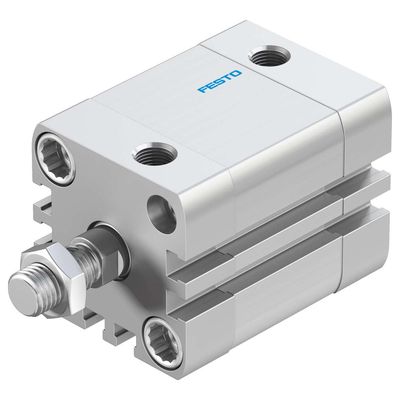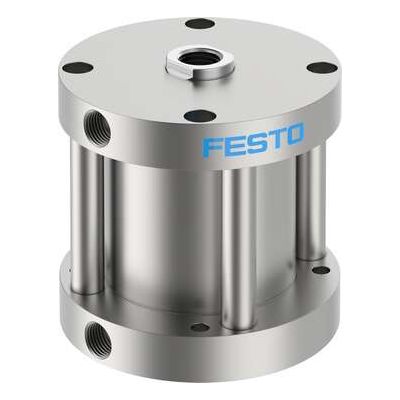What is compact air cylinder?
21.12.2022
Compact pneumatic cylinders are used in pneumatic systems where the compact design of the fixing mechanisms is of great importance. The main characteristic of this group of pneumatic cylinders is their minimum dimensions compared to the standard series. This is achieved by optimizing the design of all components of the pneumatic cylinder. Particular attention has been paid to reducing the length of the piston and rod guides compared to other series.
In today's article, we will take a closer look at compact air cylinders.
What is the Meaning of an Air Cylinder?
Pneumatic cylinders are devices for linear movement of the working body of machine tools and other mechanisms. Unlike rotary actuators, which have a rather complex design, pneumatic cylinders consist of a hollow sleeve, inside which a rod moves with the help of compressed air, creating a pulling and pushing effect on the mechanisms.
Dampers are used to reduce shock loading at the end of the stroke. With a small impact energy, this role is played by rubber rings.
Compact air cylinders are the most common linear actuators due to their small size. They are used in a wide variety of industries, from food and textiles to woodworking and building materials. Based on these prerequisites and modern technologies, we have developed lightweight and at the same time strong compact cylinders with a technopolymer body, which has made it possible to obtain compact cylinders with a high quality/price ratio.
Cylinders with piston diameters from 12 mm to 25 mm are manufactured in accordance with the requirements of the ISO 6432 standard. Their main feature is the body (sleeve and caps) made of glass-filled nylon. The mechanical properties of this material are close to aluminum, and the corrosion resistance is many times higher. This allows them to be used where the environment does not allow the use of aluminum mini-air cylinders. In this case, it is recommended to use stainless steel fasteners for mounting the compact cylinder.
How do compact cylinders work?
The compact air cylinder is a pneumatic motor that allows you to convert the energy of compressed air into the translational movement of the output link. The principle of operation of these types of pneumatic cylinders is that сompressed air from a compressor or other source is supplied to the piston cavity of the pneumatic cylinder. And the rod cavity at this moment is connected to the atmosphere with the help of a distributor, and the pressure of compressed air acts on the piston, causing it to move until it rests against the front cover.
The pneumatic cylinder makes a straight stroke, and its rod extends. To carry out the reverse stroke, it is necessary to supply compressed air to the rod end, and the piston end to be connected to the atmosphere. Under the action of compressed air pressure, the piston will move, and the rod will move.
The direction of compressed air flows into the piston and rod cavities, as well as their connection with the atmosphere or the discharge line, is carried out using special devices - pneumatic distributors.
How Many Types of Air Cylinders are There?
Any high-quality Air Cylinders are part of pneumatic systems and play the role of actuators that use the energy of compressed air. It is worth remembering that there are several types of this equipment.
Types of pneumatic cylinders:
- Piston. The principle of operation of this device is that when compressed air is supplied, a piston moves along with the rod, intentionally creating a pulling or pushing movement. In other words: this device converts the energy of compressed air into rod movement.
- Membrane. They are used exclusively in regulating types of pipeline fittings.
- Single acting. Not the most convenient version of the device mechanism. The movement is carried out in only one direction since air is supplied from only one side of the piston. Return to the reverse position can be carried out manually or using a special spring. The return stroke of the cylinder is not used as a working one, so the efficiency of such a device is sharply reduced.
- Double acting. Air is supplied to the cylinder from two sides. It should be noted that the forward and reverse stroke of the cylinder is working, which greatly increases the efficiency of the device. But we must not forget that the reverse stroke force is somewhat lower than the forward stroke.
There is a certain difference between the diameters of the manufactured pneumatic cylinders. Depending on the scale of production, you can choose the equipment individually. The most popular options are cylinders with diameters from one hundred to two hundred millimeters.
It is possible to install a special magnetic ring on the piston. This will help to monitor its position with the help of reed sensors designed for this. High-quality mounting of cylinders can be carried out using fasteners. There are fasteners for covers (flange, supports) and for the stem (fork, earring, hinge), which differ in their functionality.
What is an Air Cylinder Used For?
Compact air cylinders may be smaller, but they can be just as powerful as their larger cousins. They can be used for linear actuation and control in a wide variety of applications, including:
- Production.
- Conveyor systems.
- Food processing.
- Material handling.
- Automatic assembly or sorting.
- Bottling and bottling.
- Wire equipment.
- Automotive assembly.
- Custom-built machinery and equipment.
- Door and window frame manufacturing.
- Material handling.
- Packaging and printing.
- Plastic mold machinery.
- Robotics.
- Semiconductor processing.
While some larger pneumatic actuators are rodless, all compact pneumatic cylinders use a piston rod. Single-acting devices provide force in one direction only, either to extend or retract the piston rod. The opposite movement can be benign (occurring automatically when the air pressure is released) or activated by a spring. Compact, single-acting air cylinders are well suited for pushing or clamping workpieces, or for actuating levers or dampers.
Compact double-acting air cylinders use direct pressure to extend and retract the piston rod. This style is commonly used in applications ranging from bending and clamping to lifting and lowering, feeding, sorting, punching, and shaking.
What is the Great Advantage of a Compact Cylinder?
Compact air cylinder products offer clear advantages in terms of design versatility. These benefits include:
- Less weight.
- Adapts to more applications and environments.
- Greater flexibility in equipment design.
- Multiple mounting options to further support an efficient design and maximize performance.
- Numerous standard configurations are possible.
- The custom design offers virtually unlimited possibilities.
- Powerful, reliable performance.
- Multi-piston design can be used to increase thrust.
- Feedback sensors can be used to accommodate multiple load positions.
If space is limited, the configuration is problematic, or equipment movements are small, a standard cylinder may not work. Even if it does, it probably won't give you maximum efficiency. This reduces productivity and, ultimately, profitability.
Being able to reduce the footprint without sacrificing power, efficiency, or control can make all the difference for processors. Compact cylinders fit in limited space and provide movements that require only a short stroke as the rod slides on a small support surface, so they are ideal for light duty applications.
Since space is a common problem, we produce both traditional and compact pneumatic actuators. They all save space because they are positioned along the body. In fact, they can reduce the footprint of a machine by half.